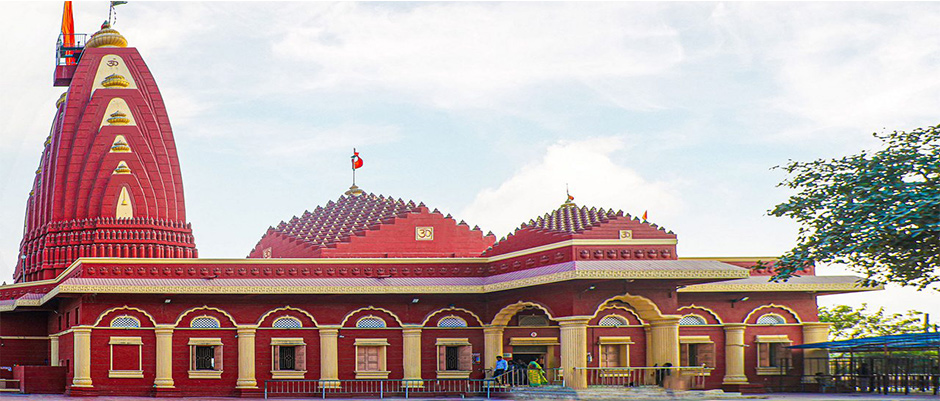
Nageshwar Jyotirling temple
Shri Nageshwar Jyotirlinga: The Divine Flame of Darukavana
Nestled along the coastal highway between Dwarka and Beyt Dwarka in Gujarat, Shri Nageshwar Jyotirlinga holds a sacred space in the hearts of Lord Shiva’s devotees. Revered as one of the twelve Jyotirlingas, it is said to be a self-manifested form (Swayambhu) of Shiva, radiating divine light from within an underground sanctum.
Serene Beauty and Timeless Craftsmanship
The temple's aura is as majestic as its mythological significance. A towering 25-meter-high statue of Lord Shiva seated in meditation welcomes pilgrims into a space filled with tranquility. Surrounding the temple is a well-maintained garden with a lotus pond, making the atmosphere meditative and deeply spiritual.
The temple complex sprawls over several thousand square feet, encased within a fortified wall with four grand entrances. Built atop black stone platforms, the temple structure showcases the elegance of the Hemadpanti architectural style — known for its use of interlocking stones without any binding mortar. The white tower of the temple gently ascends over the sanctum, standing bright and tranquil under Gujarat’s vast, clear skies.
Historical Glory and Royal Patronage
Ancient records and local tradition suggest that the temple received support and contributions from many great Indian dynasties like the Satavahanas, Rashtrakutas, and Yadavas. The restoration of this sacred space is credited to the devout Queen Ahilyabai Holkar of Indore, whose devotion led to the revival of many Jyotirlingas across India. The intricate sculptures on the temple walls depict episodes from the Ramayana, Mahabharata, and tales of celestial beings, warriors, and sages.
Darukavana – The Ancient Forest of Shiva
In scriptures such as the Shiva Purana, the location of Nageshwar is referred to as Darukavana, an ancient forest where many sages performed penance. It is said that this forest was once ruled by a demon couple—Daruk and Daruka. Daruka, known for her intense devotion to Mata Parvati, received a divine boon to rule over the mystical forest that later came to be known as Darukavana. She later misused this power and, with her husband, began tormenting hermits and devotees.
Among their prisoners was Supriya, a devoted follower of Shiva, who inspired the captives to chant “Om Namah Shivaya.” Moved by their devotion, Lord Shiva appeared, defeated the demons, and established himself in the form of a Jyotirlinga, thus blessing the land eternally.
The Pandavas and the Divine Milk River
According to legends from the Mahabharata era, during their exile, the Pandava brothers arrived at this forested region. During their exile, Bhima observed their sacred cow, Kapila, mysteriously entering a pond and reemerging after releasing milk into its waters—an event that hinted at a hidden divine presence. On digging into the lake, he uncovered a brilliant self-manifested Shiva Linga radiating divine energy. Inspired by this miracle, Yudhishthira installed the Linga there and vowed to build a grand temple dedicated to Lord Shiva.
Saint Namdev and the Shifting Door
A well-loved legend speaks of Saint Namdev, whose soulful kirtan near the temple's eastern side was so powerful that the temple entrance is believed to have turned westward to face him. It is believed that Lord Shiva turned to hear the devotion-filled songs of the saint, symbolizing the bond between the devotee and the Divine.
Shiva’s Play with the Dwarf Sages
The Vamana Purana recounts an unusual tale of Shiva testing the patience of a group of dwarf sages known as the Valakhilyas. Disguised as a naked ascetic, Shiva appeared before them and enchanted their wives, causing chaos in the hermitage. In anger, the sages cursed him, causing his Linga to separate from his body. This disturbance worried even Brahma and Vishnu, who pleaded with Shiva to restore balance. Shiva, appeased, re-joined his Linga and chose to remain in that place as a Jyotirlinga to bless future generations.
A Place Where Light Never Fades
‘Jyotirlinga’ refers to the radiant manifestation of Shiva, symbolizing an eternal beam of spiritual illumination. Devotees believe that the Linga at Nageshwar emits spiritual brilliance that dispels darkness from one's life — both internal and external. The deity here is also called Hariharatmaka, symbolizing the unified form of Shiva and Vishnu.
Spiritual Significance Today
Today, thousands of devotees visit Nageshwar Temple with unwavering faith, offering prayers and chanting mantras that echo the ancient vibrations of Darukavana. It is not just a place of pilgrimage but a spiritual powerhouse that invites seekers into deeper devotion.
Temple Timing |
Time |
|---|---|
| Temple Opens | 5:30 AM |
| Mangal Aarti | 05:00 to 05:30 AM |
| Maha Bhog Maha Aarti | 12:00 to 12:30 PM |
| Madhya Snana | 04:00 to 04:30 PM |
| Shayan Aarti | 08:30 to 09:00 PM |
| Temple Closes | 09:00 PM |
